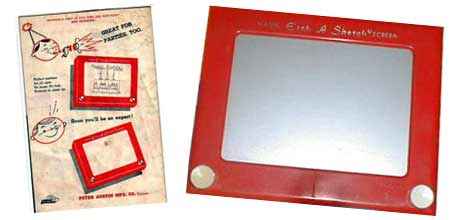Etch-A-Sketch

Synopsis of Toy
It's a nice feeling to finish an Etch-A-Sketch picture you're semi-proud of. "It actually looks like a tree this time!" you tell yourself. But then that brainy cousin of yours shows you the portrait he's Etch-A-Sketched and your pride wilts. It's a rendition of his entire family-and these aren't lopsided stick figures we're talking about either-these people actually look like the real thing, with proportion and shading and a keen eye for detail. Damn him. So you furtively shake your tree into oblivion (and between us, it looked more like a hedge than tree anyway), and when he inquires as to what you've sketched, you say funny he should ask, because as a matter of fact, you had just completed work on a divine seascape, captured at dawn and replete with a quaint schooner seen to traverse the water off in the distance, but that his ill-trained dog had just knocked it off the table and sadly, the opus was shaken away, and wasn't that just a terrible shame for art-lovers everywhere. Your cousin can only stare back through thick spectacles as you sashay to the other side of the room, shaking your finger at the dog as you go.
But let's not talk about the intra-family sketch competitions. Water under the bridge. Let's talk about the toy itself. As everyone knows, many a band and many an invention have gotten their starts in the basements and garages of the world. It was just such a place (some say it was a basement and some garage, but you get the idea), in late 1950's France, where a fellow named Arthur Granjean invented a novelty he dubbed the "L'Ecran Magique" (or "the magic screen"). Arthur took his product to the International Toy Fair in Nuremburg, Germany in 1959, and the Ohio Art Company, though it had passed the toy over the first time around, eventually decided they wanted to bring Arthur's apparatus to the States. Ohio Art put the magic screen inside a red plastic frame (nine and a half inches long), christened it the "Etch-A-Sketch," and advertised the heck out of it on print and television in the waning months of 1960. The marketing paid off, because the Etch-A-Sketch became a must-have item for Christmas, and sales went through the roof. Magic screen indeed.
An Etch-A-Sketch's backside is coated with a mixture of aluminum powder and plastic beads. There are two white knobs at the bottom of the frame, which control a horizontal and vertical rod. At the point where these two rods meet, a stylus is seen on the screen. The Etch-A-Sketch has been called the original laptop, by the way, so if you like the idea of that, then think of the stylus as the cursor-equivalent. When the stylus moves, it scrapes over the screen and leaves a dark trail in its wake. The artist can draw to his heart's content, and if boredom or frustration creeps in, a good hearty shake of the Etch-A-Sketch jumbles the powder and clears everything from the screen.
Straight lines are one thing, but a curve takes two-handed coordination because both knobs need to be twisted at once. Just the rendering of a decent-looking circle can fry the patience of an Etch-A-Sketch newcomer, and if that's not bad enough, there's the fact that the stylus' line is always unbroken. A sketcher can't jump around from point to point, in other words, without leaving a trail-so if he has gone from point A to point B, and needs to get back to A without the appearance of two lines, the only way to do it is to retrace his steps perfectly and travel back over the same line he's already drawn. This is painstaking, and nearly impossible to do perfectly.so for a complex picture, advance planning is a necessity.
In the 1970's, Ohio Art issued 'Hot Pink' and 'Cool Blue' frames, and for the toy's 25th anniversary in 1985, the company offered the Executive Etch-A-Sketch-boasting a snazzy silver frame, a hand-carved signature at the top of the frame and jeweled drawing knobs! It priced in at $3,750 back then, so you better have been ready to devote the rest your days to stylus art. There are even models with color and sound effects, and even the Etch-A-Sketch "action pack," which included different puzzle and game overlays that could be placed atop the screen. But the best-selling version, and the one indelibly ingrained in our toy culture memories, is the classic red.
Best of all, there are some bona fide Etch-A-Sketch artistes out there-people who twist those knobs for twenty and thirtysomething hours, create true masterpieces, then drill a hole and drain the toy of its aluminum dust so that the picture can't be shaken away. There is the Etch A Sketch Club, founded in 1972; there are websites and calendars.and you can be sure that none of these hall of fame galleries will include the type of pathetically pedestrian hedge-trees mentioned above. Over one hundred million of these erasable gray canvases are out there, calling out to you to knob-twist the night away.why not heed the Etch-A-Sketch call?
Release History of Toy
1960 - The classic Etch-A-Sketch, with red frame1971 - "Hot Pink" and "Cool Blue" models
1985 - Limited edition Executive model
1993 - The Color Etch-A-Sketch
